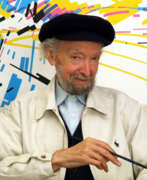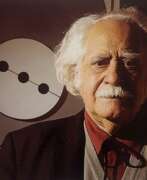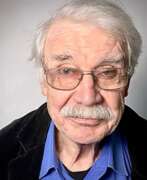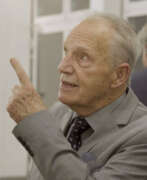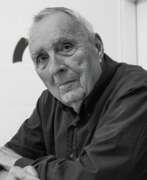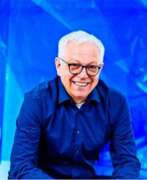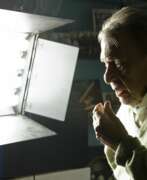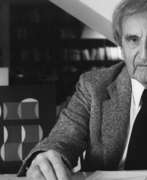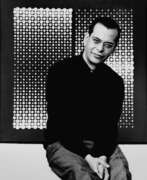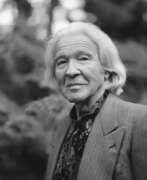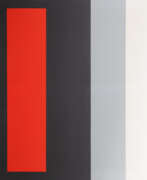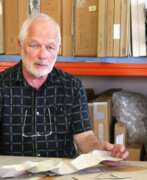Concrete art 21st century
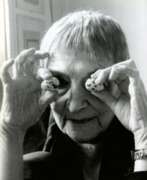

Mirella Bentivoglio is an Italian painter, sculptor and poet, representative of visual concrete poetry.
She was trained as an art historian and artist in Italy, Switzerland and England, and in the 1960s she joined the concrete poetry movement and began to use elements of the alphabet to create expressive images. A few years later, Bentivoglio became increasingly interested in sculpture, turning letters into three-dimensional forms. In many of her later works, two images, a book and an egg, began to recur.
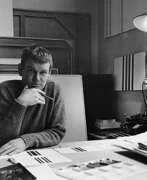

Andreas Brandt is a contemporary German artist. He developed his own rigorous and daring vision of freedom early on, which is embodied in his parsimonious mathematical compositions.
Andreas Brandt is most closely associated with Swiss artists of concrete art, in particular Max Bill and Camilla Greser.
In his work, Brandt aimed to present colour "as an autonomous form" and show the "tension it creates with other autonomous forms in a rectangular area".
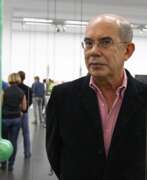

Antonio Manuel Lima Dias was a Brazilian artist and graphic designer. He was a prominent figure in concrete art. He studied at the National School of Fine Arts of Rio de Janeiro.
Antonio Lima Dias has undertaken study trips around the world since 1965, travelling to Paris, Milan, Berlin, New York and Nepal. Diaz's artistic style was characterised by a bold and confrontational approach. He used a combination of figurative and abstract elements, bright colours, strong lines and dynamic compositions.
In 1992 he became a professor at the Sommerakademie für bildende Kunst in Salzburg, Austria, and the following year at the State Academy of Fine Arts in Karlsruhe, Germany.One of his characteristics is his use of handmade paper, combining texture and colour in his work. One of his main characteristics is his use of handmade paper, combining texture and colour in his works.


Bruno Erdmann was a German artist of informal and concrete painting. He was known for his contribution to the field of abstract art.
Bruno Erdmann's work was mainly focused on abstraction, where he sought to express emotions and ideas through non-representational forms and colours. He adopted the principles of abstract expressionism, emphasising spontaneous and gestural brushwork as well as an exploration of texture and surface.
Throughout his career, Erdmann experimented with various materials and techniques, including oil and acrylic paints, mixed media and collage. He often used bright and bold colours, creating dynamic compositions that conveyed a sense of energy and movement.
Although Erdmann's work is associated with abstraction, he explored other artistic styles and genres throughout his career. He experimented with figurative elements, landscapes and still lifes, demonstrating his versatility as an artist.
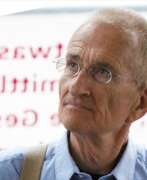

Jochen Gerz is a German conceptual artist who lived in France from 1966 to 2007. His work involves the relationship between art and life, history and memory, and deals with concepts such as culture, society, public space, participation and public authorship. After beginning his career in the literary field, Gerz has in the meantime explored various artistic disciplines and diverse media. Whether he works with text, photography, video, artist books, installation, performance, or on public authorship pieces and processes, at the heart of Gerz's practice is the search for an art form that can contribute to the res publica and to democracy. Gerz lives in Sneem, County Kerry, Ireland, since 2007.


Torben Giehler is a German abstraction artist.
After studying at the Boston Academy of Art he returned to Germany.
Giehler's style of painting is based on abstract compositions of geometric forms. He digitally edits his sketches and then uses multiple layers of acrylic paint to create large-scale works. In this way the artist manages to convey his own impressions of mountains, streets or buildings.
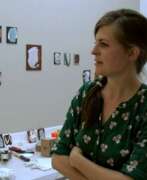

Henriette Grahnert is a German artist, designer and graphic artist. She graduated from the Academy of Art and Design in Leipzig and works in Dresden and in Leipzig.
The artist uses and combines a variety of painting traditions: classical abstraction and concrete painting, minimalist traditions and bad painting, American color field painting and pop art. Peeling paint, random brushstrokes, drips, smudged duct tape - remnants of the painting process are the elements that make up Grahnert's paintings.
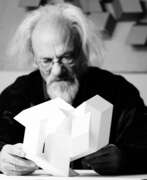

Hagen Hilderhof is one of the outstanding German constructivist sculptors of our time.
Initially his sculptures arose from intensive research into mathematical rhombohedrons, their variable basic shape and its modifications. Later he succeeded in creating a range and variety of geometric sculptures that impress not only with their precise construction and design, but also with their aesthetic beauty.
Hagen Hilderhof is a member of the Düsseldorf Secession and the Darmstadt Secession and is also a member of the Düsseldorf Artists' Association. His large-format geometric-abstract metal sculptures can be found in public spaces in Germany.
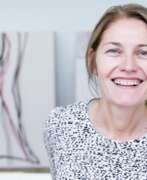

Suse Krawagna is an Austrian artist and graphic artist.
Suse Krawagna studied at the Academy of Fine Arts in Vienna and at the Royal College of Art in London. Her work is based on the observation of architectural details, her attention is drawn to shapes, clusters of forms and details of objects. Suze creates her paintings in series, demonstrating their dramatic variation through slight variations in lines.
Suse Krawagna has won numerous awards, including the Anton Feistauer Award and others. Her work has been shown in solo and group exhibitions both in Austria and abroad, and is also presented in private and international exhibitions.
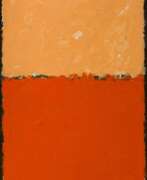

Armin Martinmüller is a German painter who lives and works in Stuttgart.
Inspired by color-field painting, the artist creates miniatures of color space in a system of connecting rectangular forms. In these postcard-sized acrylic paintings on black cardboard, he explores the play of several colors, usually muted by overpainting.


François Morellet was a French contemporary abstract painter, sculptor, and light artist. His early work prefigured minimal art and conceptual art and he played a prominent role in the development of geometrical abstract art and post-conceptual art.
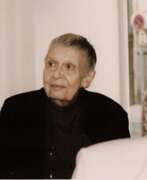

Aurélie Nemours is a French abstractionist painter.
Aurélie Nemours created abstract geometric paintings, developing her own style based on pure colors and geometric shapes taken from the square, but without dogmatism or systematism. Her compositions are strictly arranged on a plane based on the intersection of horizontal and vertical. This painstaking work culminates in a meditative asceticism confined to squares and rectangles, black or gray, space and matter.
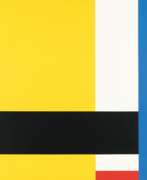

Jo Niemeyer is a German graphic artist and designer.
He moved from photography and various media to painting, based on observations of nature through mathematics. Niemeyer's works have been mentioned in numerous international publications and films, and are in public and private collections and museums worldwide. Today Jo Niemeyer works and lives in Germany, France and Finland.


Rafael Soriano was a Cuban painter who lived in the United States.
He has started painting in 1940s, and soon became one of the primary practitioners of concrete art in Cuba and Latin America.
After Soriano's death in 2015, his family created the Rafael Soriano Foundation in order to encourage a deeper appreciation of his artwork as one of the major Latin American Artist of his time. In particular, this Foundation promotes exhibitions that focus on his work in order to be placed in museums and collections around the globe. They also maintain a main database that catalogues all works made solely by Soriano.
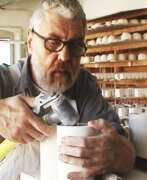

Kurt Spurey is an Austrian artist and ceramic sculptor.
He studied silicate technology at the Technical and Industrial College in Vienna. Spurey is known for porcelain vessels, bowls and vases in the style of abstract concretism and also creates outdoor sculptures in steel and aluminum, concrete and terracotta.
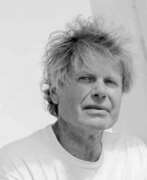



Heiner Thiel is a German sculptor and curator. He is an exponent of concrete art.
Heiner Thiel works with a variety of sculptural materials. In the 1970s he was fascinated by bronze casting, but in the 1980s he began to experiment with steel sheets, which he pretreated in a complex painting process. He then formed these steel sheets into abstract wall reliefs. Depending on the angle of view, one seems to see a different object, parts of the relief appear in the foreground or disappear, bring out the illusions of perception and thus invite reflection on the theme of perspective.
Color forms one of the central themes in Thiel's more recent works and adds the dimension of light or shadow to the interplay with perspectives, thus creating new experiences of perception for the viewer.
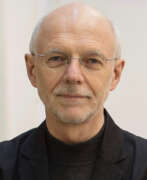

Leo Zogmayer is an Austrian conceptual artist, graphic artist and sculptor.
Zogmayer studied at the Vienna University of Applied Arts and works in a variety of techniques, including drawing, graphics, photography, computerized drawings, painting, glass painting, and sculpture in a wide variety of materials.
Zogmayer expresses himself primarily through language and text. His sculptures, created in the tradition of concrete modernism, are completely abbreviated, reduced to a minimum in terms of contour, form, color, and volume. The artist is concerned not so much with the creation of reality as with the dismantling of structures; he is interested in the rejection of definitions, conventions or models that limit people's perception and thinking.
